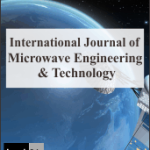Editor Overview
IJMET maintains an Editorial Board of practicing researchers from around the world, to ensure manuscripts are handled by editors who are experts in the field of study.
Publisher
JournalsPubAn Imprint of Dhruv Infosystems Pvt Ltd
A-118, 1st Floor, Sector-63, Noida, U.P. India,Pin-201301
E-mail: [email protected]
(Tel):
(Mob) (+91) 9810078958, +919667725932
Focus and Scope

About the Journal
International Journal of Microwave Engineering and Technology is a peer-reviewed journal that provides academicians and industries with high quality research papers and reviews in microwave engineering. Journal is positioned to provide transformation in the way scientific articles are communicated and is determined to publish high impact articles.
All contributions to the journal are rigorously refereed and are selected on the basis of quality and originality of the work. The journal publishes the most significant new research papers or any other original contribution in the form of reviews and reports on new concepts in all areas pertaining to its scope and research being done in the world, thus ensuring its scientific priority and significance.
Focus and Scope
1. Microwave transmission: Dynamic Nuclear Polarization, Signal enhancement, Magic Angle Spinning, Quasi-Optic Microwaves, Transmission line technique, Permittivity, Added water content, Adulteration, Granular materials, Heating uniformity, Electric field, Microwave processing, Zero emission vehicle, Environmental protection, Morphology configuration, Selective.
- Artificial dielectrics Microwave amplifiers: Balun, CMOS, Transmission line, Common ground, Artificial dielectric, Imbalance compensation, Front-end, Power added efficiency (PAE), High efficiency, Power amplifier (PA), Ceramics, Tungstate, Thermal conductivity, Percolation, Polysaccharides, Grafting, Microwave irradiation, Properties, Microwave susceptibility, Aggregates, Asphalt Mixture.
- Transmitters, Planar Circuits: Wire bonding, Interconnect, Matching circuit, GCPW, Microstrip, Ventral tegmental area, Nucleus accumbens, Distal dendrite, Retrograde transport, Ultrastructure, coplanar waveguide (CPW), transmission line, Miniaturization, Printed circuit board, Wilkinson power divider, Size reduction factor (SRF), Zigzagging line, non-contact sensor transmitter, Electromagnetic transmitter, Passive telemetry.
- Quarter wave transformer, Active array antenna, Antenna Design: Transmission line, scattering parameters, quarter-wave transformer, matching, Sonet, Thermal deformation, Prediction and compensation, Electromagnetic performance, Active membrane phased array antenna, Structural-electromagnetic coupling, Electromagnetic performance, Membrane wrinkles, MetasurafceVia-holes, Microstrip patch, Substrate integrated waveguide (SIW), Radiation Pattern Modeling, Beamforming, Multi-scale, Microchannel cooling, Smart networking, Smart sensors, Vehicle networks, Microstrip patch antenna, Superstrate, Metamaterial, Partially reflective surface, Band rejection, cancer detection.
- WIPL-D Microwave: Wire antenna, Fractal, V-Koch electric dipole, Radio antenna array, Calibration, Air showers, Electromagnetic compatibility, Equivalent dipoles, Anechoic chambers, Open-area test sites, Faraday cages, Sparse processing, Cosmic rays, Neutrinos, Radio emission, Antenna Design, Arrays & Radomes, Antenna Placement, RCS / Scattering, Low Frequency, Miscellaneous.
- Microwave amplifiers: Doherty, Envelope tracking power amplifier, Power added efficiency, Phase diffusion, Nonlinear oscillations, Quasi-linear response theory, Class-F amplifier, High efficiency Power added efficiency, Heterojunction Bipolar Transistor, Circuit synthesis, Hybrid microwave circuits, Matching network, Microwave quantum illumination, Optical parametric amplifier, Lower error probability.
- Microwave Components and Circuits: Design, Interconnects, Microwave ceramics, Coupler, Circuit geometry selection, Compact cell, Miniaturization, Simulation-driven design, Electromagnetic simulation, Robust design, Tolerance optimization, Feature-based models, Knowledge-based surrogates, Domain confinement, Simulation-driven design, Design optimization, Waste printed circuit boards (WPCBs), Non-metallic components (NMC), Epoxy resin, Glass fiber, Chemical recovery.
- Scattering Parameters: Tenderness, Lorentzian distribution, Diffusion equation, Hyperspectral backscattering imaging, Electromechanical, model S-parameters, Piezoelectric device, Resonance, Colloids, Iterative method, Loop antenna, Multilayer structure, Radiation pattern, Transformer winding displacement, On-line monitoring, Microwave networks, Network model, Coplanar waveguides, Microwave conductivity, thin films.
- Smith Chart and Its Applications: Nomogram, graphical calculator, electrical and electronics engineers, radio frequency (RF), transmission lines and matching circuits, multiple parameters, impedances, admittances, reflection coefficients, scattering parameters, noise figure circles, constant gain contours, unconditional stability, mechanical vibrations analysis, used at or within the unity radius region.
- Transmission Lines: Artificial intelligence, Digital relay, Distance protection, Fuzzy logic, Neural network, Wavelet transform, fault detection, instantaneous power, high impedance faults, Euclidean distance, Phasor measurement unit (PMU),Supervisory control and data acquisition (SCADA),State estimation, Power flow, Parameter identification and estimation.
- Waveguides: Pedestal waveguides, rare earth ions luminescence enhancement, Optical amplifiers, gain enhancement due to gold nanoparticles, Integrated nonlinear optics, Polydimethylsiloxane (PDMS), Infrared and Raman spectroscopy, Near-infrared, Visible and UV spectroscopy, Optical materials, Waveguide application, Stress, Photo-elastic, Birefringence, Loss, Multimode.
- Planar Circuits and Passive Circuits: Inkjet printing, Passive components, Multilayer, Printed electronics, Planar PEMFC, Printed circuit board (PCB), Self-breathing, Stability of performance, Corrosion, Long-term operation, Production process, Open cathode, Air-breathing stack, Passive fuel cell, Monopolar stack, Planar antennas, Microstrip technology, GPS, Sensor, Wireless, Remote query, Semi-passive circuit, Physical layer, MAC protocol, Routing protocol, Mobility.
- CAD tools in RF/Microwave circuit design: Nylon 6, 3D printing, Additive manufacturing, RF/microwave structure, Fused deposition modeling (FDM), Relative permittivity, Anisotropic media, CAD/EDA, Linear regression models, Tunable circuits and devices, VHDL-AMS, Artificial neural network, Analog and radio frequency, Deep learning, Machine learning, Artificial intelligence, Integrated circuits, Synthesis, Optimization, Filters, Dual material gate, Gate all around, Gate stack, Gate material engineered (GME), Schottky-barrier (metal) source/drain, Wireless applications.
- ABCD or Ray transfer matrix: Laguerre–Gaussian Schell-model beam, Bessel–Gaussian Schell-model beam, Beam propagation, Astigmatic interferometric particle imaging, Holography, Volumetric droplet, Size, Depth position, Galilean telescope, Multimode optical fiber coupling efficiency, Knife-edge Profilometer, Mathematica, Galvanometer, the generalized Fresnel transform, the bipartite entangled state, Generalized ABCD law, Similarity transformation, IWOP technique.
Open Access Statement
IJMET is an open-access (OA) publication which provides immediate open access to its content on the principle that making research freely available to the public supports a greater global exchange of knowledge. All published works will be available to a worldwide audience, free, immediately upon publication. Publication in the journal is subject to payment of an article processing charge (APC). The APC serves to support the journal and ensures that articles are freely accessible online in perpetuity under a Creative Commons licenses.
Publication Ethics Statement
IJMET fully adhere to Code of Conduct of Publication Ethics (COPE) and to its Best Practice Guidelines. The Editorial Team enforces a rigorous peer-review process with strict ethical policies and standards to ensure the addition of high-quality scientific studies to the field of scholarly publication. In cases where ctit becomes aware of ethical issues, it is committed to investigating and taking necessary actions to maintain the integrity of the literature and ensure the safety of research participants. Click here to read more about the Research & Publication virtue ethics
Content Disclaimer
All IJMET the information’s, opinions, and views mentioned here represents the authors and the contributions of the articles. Publication of articles, advertisements, or product information does not constitute endorsement or approval by the journal. cannot be help responsible for any error or consequences while using the information updated in this journal. Although every effort is done by ctit to see that there’s no any inaccurate data, misleading data, opinion or statement within the journal, the data and opinions appearing in the articles are the responsibility of the contributors concerned.



